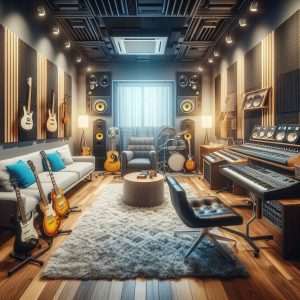The Perfect AC Settings for Music Studios
Why AC Matters in a Music Studio
At first glance, AC might seem like just another comfort feature, but it’s an unsung hero in a music studio. Here’s why:
- Instruments Are Sensitive – Stringed instruments like guitars and violins can warp, drum skins can loosen or tighten, and pianos can go out of tune if the room temperature and humidity aren’t stable.
- Sound Quality Can Be Affected – AC noise can interfere with clean audio recordings, and too much airflow can alter microphone sensitivity.
- Electronics and Gear Need Protection—Computers, mixing boards, and other music tech generate heat. Overheating can lead to malfunctions, crashes, or even permanent damage.
- Comfort = Creativity – If you’re sweating bullets or shivering in your seat, you won’t be focused on making great music. A stable, comfortable climate helps you stay in the groove.
The Perfect Temperature: Not Too Hot, Not Too Cold
So, what’s the ideal temperature for a music studio? Most professionals recommend keeping it between 68°F and 74°F (20°C —23°C). This range keeps you comfortable without drying out instruments or overheating equipment.
- Too Hot (Above 75°F/24°C): Instruments can expand, wood can warp, and sweaty hands can make playing difficult. Electronic gear hates heat!
- Too Cold (Below 65°F/18°C) – Cold air can stiffen guitar strings, tighten drumheads too much, and make it uncomfortable for musicians to perform at their best.
Temperature is just one piece of the puzzle—humidity is equally important. Too much moisture in the air can make instruments swell, while dry air can cause cracks in wooden instruments. The ideal humidity level for a music studio is between 40% and 50%.
How to maintain it:
- Use a humidifier or dehumidifier to regulate moisture.
- Keep a hygrometer in your studio to monitor humidity levels.
- Store delicate instruments in cases when not in use, especially in extreme weather conditions.
How to Keep AC Noise Out of Your Recordings
One of the most significant issues with having an AC in a music studio is unwanted background noise. A loud HVAC system humming in the background is the last thing you want in your mix. Here’s how to keep the cool air without the noise:
- Choose a Quiet AC Unit – Some models are designed for low-noise operation. Look for split AC systems or ductless mini-splits—they’re quieter than window or portable units.
- Clever Vent Placement – Position air vents away from microphones and recording areas to minimize interference.
- Use Diffusers and acoustic Panels. These can help redirect airflow and absorb excess noise. Plus, they improve sound quality in general!
- Turn AC Off During Takes—If the AC is off while recording, turn it on and back on between takes. Just make sure the room doesn’t heat up too quickly.
Bonus Tips for a Cool & Creative Studio
- For Home Studios: If you’re converting a small room into a studio, consider a portable AC unit with a noise-reduction setting or a ductless system for quiet operation.
- For Pro Studios: Invest in soundproof HVAC solutions, like installing an air return system that keeps cool air circulating without excessive airflow noise.
- Energy Efficiency Hacks: Use smart thermostats that adjust based on room usage and schedule maintenance for your AC unit to keep it running efficiently.
A music studio is more than just a space—it’s where creativity happens. A perfectly tuned AC system isn’t just about comfort; it’s about protecting your instruments, maintaining sound quality, and keeping your creative energy at its peak. With the right temperature, humidity, and noise control strategies, your studio can be the perfect mix of beats and breeze. So, the next time you’re setting up for a session, remember: a cool studio is a creative studio.
 There’s nothing worse than laying down a killer track, only to have the room turn into a sauna—or worse, a freezing icebox that makes your fingers too stiff to play. Whether you’re a professional music producer or a weekend jam session enthusiast, air conditioning can make or break your studio experience. A well-regulated climate doesn’t just keep you comfortable—it affects your instruments, recording quality, and overall workflow. That’s why many studios rely on ducted air conditioning for consistent, even cooling without the noise of traditional units. So, let’s dive into the sweet spot of AC settings for the ultimate music studio environment.
There’s nothing worse than laying down a killer track, only to have the room turn into a sauna—or worse, a freezing icebox that makes your fingers too stiff to play. Whether you’re a professional music producer or a weekend jam session enthusiast, air conditioning can make or break your studio experience. A well-regulated climate doesn’t just keep you comfortable—it affects your instruments, recording quality, and overall workflow. That’s why many studios rely on ducted air conditioning for consistent, even cooling without the noise of traditional units. So, let’s dive into the sweet spot of AC settings for the ultimate music studio environment.